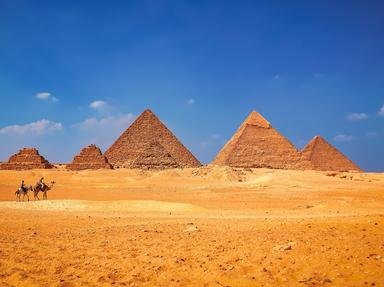Quiz Answer Key and Fun Facts
1. The Egyptian god known as the "hidden one" had the goose as a sacred bird. Who was he?
2. What was the insulting demand the Hyksos pharaoh Apepi or Apophis (1585-1542 BC) sent to the Theban ruler Seqenenre Tao II?
3. The Egyptians had a canal linking the Nile and the Red Sea.
4. Who is the "odd man out"?
5. When did the term Pharaoh start to be used for the ruler of Egypt?
6. The form of the royal titulary was established in the middle kingdom. How many sections was it in?
7. Percy Bysshe Shelley's poem "Ozymandias" was inspired by a shattered colossal statue. Whom had it shown?
8. Who is the only king whose tomb was found intact by modern archaeologists?
9. Which of these words is derived from ancient Egyptian (via Greek)?
10. The burial place of Shepseskaf (last king of the fourth dynasty and successor to the builder of the smallest Giza pyramid) was not a pyramid although the Egyptians sometimes described it as a pyramid. What shape was it?
11. Who built the last known royal pyramid in *Egypt* i.e. excluding the later Nubian ones?
12. The Instructions of Dua-Khety (also called 'The Satire of the Trades')dates from the Middle Kingdom. Which of these summaries of a trade is incorrect?
13. Which of the Ptolemaic (Macedonian) rulers (330-30BC) is believed to have been the first to speak Egyptian?
14. Which of these was *not* found at the city of Hierakonpolis (originally called Nekhen, now called Kawm Al-ahmar), which flourished during pre dynastic and early dynastic periods (up to about 2700 BC)?
15. The earliest known life size statue of a human (from 3500 BC) was found at Hierakonpolis. It had been almost totally reduced to chips but one part was still recognizable. What part was it? In view of the damage statues often incur this survival is somewhat unusual.
Source: Author
TNREES
This quiz was reviewed by FunTrivia editor
bloomsby before going online.
Any errors found in FunTrivia content are routinely corrected through our feedback system.

